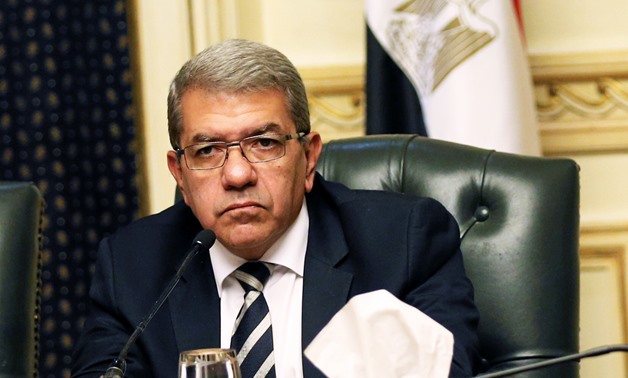
Minister of Finance Amr El-Garhy- Press Photo
As part of the government’s strategy to promote the financial inclusion of citizens and enhance the involvement of the banking sector in business transactions, the Ministry of Finance started implementing the Government Fiscal Management Information System (GFMIS) this month.
The strategy includes increasing dependency on electronic systems in payments and the collection of state revenues and expenditures.
Taking the first steps toward the initiative, state institutions have halted the use of all paper checks beginning November 29.
On that same day, various sub accounts of different administrative bodies were scheduled to be closed to complete their integration with the Treasury Single Account (TSA) banking system at the Central Bank of Egypt (CBE). The e-payment and ATM systems are also to be automated and integrated with the TSA banking system at the CBE.
The application of the GFMIS comes as part of the Ministry of Finance’s plans to boost fiscal and accountancy reform, upgrade the performance of the public administrative units and enhance the transparency, accountability, efficiency and cost-efficiency of public services.
“The system targets tightening the monitoring on state accounts and halting the use of paper checks, which will help the ministry follow up on revenues and spending on a continuous basis,” Minister of Finance Amr El-Garhy said in a statement issued late last month.
Slowly, but hopefully surely
The GFMIS project is not new since the same strategy was underway in 2015 and the date of halting the usage of paper checks in all government payments was originally set for November 2015.
“It was so difficult to apply the strategy back then because the government’s digital network in some governorates and ministries was not strong enough,” tax accountant Mohamed Abdel Azim says. He explains that the Ministry of Finance was transparent about this issue and ordered tax directorates and local offices to report their technical problems to the ministry. “We hope this obstacle is now fixed.”
The government was supposed to have an inclusive electronic payment system ready as it signed a LE 330 million contract with stateowned digital payments company E-Finance in 2007.
“Digitalizing state payments and spending would control the government’s expenditures especially [when it comes to] the salaries of public employees,” Nader Ragab, a financial risk analyst at a private-sector bank in Egypt, says.
The new system is expected to save an average of LE 5 billion each year, Vice Minister of Finance for Treasury Affairs Mohamed Maait said in an official statement last month. “It can, in some cases, save around LE 10 billion, depending on the state budget,” Maait explained; adding that the state’s current strategy aims to swiftly convert into an electronic payment system, instead of relying on paper transactions and checks. Maait affirmed that the infrastructure and communication networks are being upgraded to
receive the new system.
More digital services introduced
Digitalizing data and services has been a point of focus of thegovernment since 2017. As a first step in the application of the New Investment Law, the Investors Service Center was launched in June. Aiming to reduce bureaucratic measures while offering electronic services to investors, the center would also respond to investors’ inquiries about electronic establishment for companies, investment opportunities in different governorates, free zones and settlement measures of investment disputes.
Two months later, Minister of Investment Sahar Nasr and Minister of Immigration and Egyptian Expatriate Affairs Nabila Makram announced the launch of the One-Stop Shop service for Egyptians abroad. The digital service will help Egyptians living abroad invest domestically through a single unified ‘service window’ at the Investors Services Center and will provide all necessary investment services electronically as well.
In August, the Egyptian Financial Supervision Authority (EFSA) disclosed the first digital map for microfinance that shows the licensed bodies that practice microfinance. The map includes licensed companies, communities and civil organizations, along with their activities in different governorates. It also lists the branches of the macro-financial bodies, their addresses, the number of clients and the value of finance in each governorate.
The last milestone in that regard came in October, when the Ministry of Industry and Foreign Trade launched the interactive industrial investment map on the ministry’s website.
Encompassing more than 4,000 industrial opportunities in eight sectors, the ministry’s officials paid field visits to more than 100 industrial zones across Egypt to collect data about them to prepare this map, identifying their production volume and production capacity.
Government-sponsored plan for electronic payments
The government is working to increase dependence on electronic payments to boost economic outcome, facilitate access to government services for citizens and upgrade state institutions’ processes.
For this purpose, Prime Minister Sherif Ismail met last month with the CEO of Mastercard Ajaypal Singh Banga to discuss incorporating digital payment in the services sectors, including health, education, transport and communication, especially in the New Administrative Capital.
These initiatives came as President Abdel Fattah al-Sisi issued a decree in February to establish the National Council for Payments, which will work to achieve financial inclusion and encourage online payments. The council’s work will support digital transactions through ATM machines and internet or mobile phones, as well as organizing electronic payments companies operating in Egypt.
Egypt’s government has been working to reach financial inclusion since only 10% of Egyptians have bank accounts, according to official estimates, with the majority of employees being paid in cash.
Around LE 2 billion of electronic payments have been carried out through credit or debit cards in Egypt in 2017 so far, compared to LE 500 million in 2012, according to a report from online payment platform Payfort. This figure proves that expansion in using electronic payment systems in the country is indeed taking place; in addition to the fact that the number of market players are increasing to include more companies.

Comments
Leave a Comment